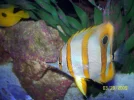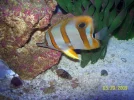ffm
Reefing newb
Last week I got my CB Butterfly fish. The first two or three days he stayed hidden. When he finally came out and began swimming around, I notice a large white spot on his fin. He seems to favor this fin, but so far his movements and eating seem to be normal, at least for what I have seen of this type of fish before. I have attached a couple of pics to show you what I am talking about. Thanks!!


